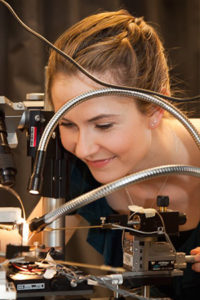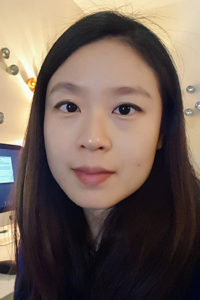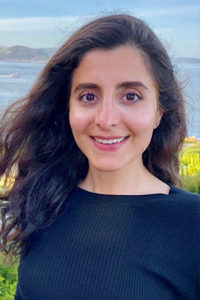 ARIADNA AMADOR, COLUMBIA UNIVERSITY
ARIADNA AMADOR, COLUMBIA UNIVERSITY
Mouse model of childhood epilepsy caused by a de novo GRIN2A missense mutation
GRIN2A codes for a subunit of NMDA receptors (NMDAR), ion channels that play important roles in several neurological disorders, including epilepsy. A de novo missense mutation (S644G), identified in a child with epileptic encephalopathy was knocked in using CRISPR/Cas9 in the mouse model. The mutation causes mouse developmental delay, spontaneous lethal seizures in homozygous pups and susceptibility to electroconvulsive seizures in adults in the ECT, as well as other behavioral aberrations. The mice were treated with the therapies used in the child, targeting NMDAR in general. We also assessed the efficacy of drugs targeting GRIN2B, successfully increasing the latency to lethal seizures.
 CHLOE AUDIGIER, JOHNS HOPKINS UNIVERSITY
CHLOE AUDIGIER, JOHNS HOPKINS UNIVERSITY
Can a $30 device provide real-time thermometry and replace $3M MR imaging system?
Uterine fibroids are non-cancerous tumors of the uterus. They are the most common female pelvic tumor, affecting about one in four women. Even though benign, they represent a health risk, and often require medical intervention. The only guaranteed cure for uterine fibroids is hysterectomy, or the surgical removal of the entire uterus, which results in infertility, sexual dysfunction, increased risk of early menopause, osteoporosis and heart disease. HIFU (high intensity focused ultrasound) is a promising and non-invasive alternative. This ablation technique sends ultrasound waves to destroy the tumor by increasing its temperature and the temperature of a small amount of surrounding tissue to prevent possible recurrences. The challenge is to achieve a complete tumor ablation, while at the same time, sparing as much as possible healthy tissue around. To do so, clinicians use magnetic resonance imaging (MRI) to monitor the ablation, more specifically to follow the temperature evolution during the procedure. Unfortunately, MRI is expensive, cumbersome and many patients have MR contraindications. It is also a logistic barrier by limiting this solution within the radiology department of large hospitals and away from obstetrics and gynecology clinics.
We propose a low-cost alternative. We built separate ultrasound elements able to evaluate the temperature evolution in the target tissue, and we operate it with already existing HIFU systems. This setup provides limited information compared to MRI. Therefore, we combine it with a biophysical model which predicts the ablation and temperature evolution. Integrating those two sources of information is crucial in realizing an inexpensive yet comprehensive method for intra-procedural monitoring of the ablative process.
We created a new use for an already invented therapy system, and by switching the monitoring from MRI to ultrasound, we improved its cost and logistical use. With this simple, portable and low-cost system, we believe that we can monitor thermal ablation, and make HIFU procedure available to patients who do not necessarily have access to MRI.
 LINDSAY CLEGG, ASTRA ZENECA
LINDSAY CLEGG, ASTRA ZENECA
Leveraging a Past Clinical Trial to Quantify the Cardiovascular and Renal Effects of SGLT2 Inhibitors in Type 2 Diabetics
Two sodium-glucose co-transporter-2 inhibitors (SGLT2i) reduced the incidence of major adverse cardiovascular events (MACE), all-cause mortality (ACM), and renal events in recent cardiovascular outcomes trials (CVOTs). Observational real-world evidence suggests class effect benefits that include a third SGLT2i, dapagliflozin, for which the CVOT is still ongoing. We examined the placebo arm of the EXSCEL CVOT, which evaluated a different class of drug, to determine whether the effects of drop-in open label dapagliflozin on MACE, ACM, and estimated glomerular filtration rate (eGFR) were consistent with the SGLT2i class as a whole.
SGLT2i drop-in therapy occurred in 10.6% of EXSCEL participants, with 5.2% taking dapagliflozin. To address non-randomized SGLT2i use in EXSCEL, we propensity-matched SGLT2i users to nonusers (n=709 per group) with the same likelihood of initiating SGLT2i treatment based on demographics, medical history, disease state, and laboratory measurements prior to SGLT2i drop-in. Time-to-first adjudicated MACE and ACM were analyzed using Cox regression. eGFR slopes were compared between matched cohorts using a mixed-model repeated measures analysis.
In adjusted analyses, SGLT2i users (compared with nonusers) had a numerically lower risk of MACE, and a significantly lower risk of all-cause mortality. Compared with nonusers, eGFR decline over time was significantly slower for SGLT2i users overall and for dapagliflozin users. This post hoc analysis of the placebo arm of EXSCEL supports a beneficial class effect for all SGLT2i, including dapagliflozin, for reducing overall mortality and slowing eGFR decline.
 BRITTNY DAVIS LYNN, NIH / NATIONAL CANCER INSTITUTE
BRITTNY DAVIS LYNN, NIH / NATIONAL CANCER INSTITUTE
Descriptive and Molecular Epidemiologic Approaches to Inform Racial Disparities in Breast Cancer Risk
Breast cancer is the most common malignancy among women of all races in the United States, with an estimated 266,120 new cases of breast cancer and 40,920 breast cancer deaths in 2018. Breast cancer is a heterogeneous disease, both etiologically and clinically. There are two major subtypes of breast cancer that are based on estrogen receptor (ER) status (positive and negative), with ER negative breast cancers being the early-onset, more aggressive form. Breast cancer subtypes are known to affect racial/ethnic populations differently. For example, younger Black women are disproportionately affected by ER negative breast cancer and have the highest mortality rate due to overall breast cancer. Additionally, there is a geographical disparity that exists among subtypes in the US, with increased incidence of ER positive breast cancers in the North- and Mid-West and ER negative breast cancers affecting more women in the Southeast. Unfortunately, these racial and geographical disparities are not well understood.
The purpose of my research is to advance our understanding of breast cancer risk in underserved populations, using a range of descriptive and molecular epidemiologic approaches. Leveraging descriptive age-period-cohort analytic models, I examine current trends and predict future breast cancer rates by tumor subtype, race/ethnicity and region. Observations gleaned from the evaluation of secular trends in breast cancer incidence may provide etiologic clues. For example, the divergence of ER positive/negative incidence rates likely reflects changes in screening and/or risk factors with differential effects for ER positive and ER negative breast cancers. These descriptive analyses complement my molecular epidemiologic research identifying biomarkers for breast cancer in young black and white women. Overall, this research serves to elucidate the driving forces behind racial and geographic disparities in breast cancer incidence and mortality, as well as develop effective screening and prevention strategies.
 SARAH DOUGHERTY, JOHNS HOPKINS UNIVERSITY
SARAH DOUGHERTY, JOHNS HOPKINS UNIVERSITY
Serotonin axon regeneration in the adult mouse neocortex.
Central nervous system repair has long been thought improbable if not impossible. However, contrary to these widely held beliefs, recent evidence suggests that serotonin axons in the brain can regrow and recover function following injury. In mouse models of chemical and physical injury, axons of serotonin-using neurons have been shown to undergo long-distance regeneration, including directly from severed ends. These axons can extend through growth inhibitory zones of tissue scarring resulting from a stab wound or blunt impact traumatic brain injury. To investigate this inherent capacity for regrowth and elucidate potential mechanisms through which this occurs, we perform longitudinal imaging studies and expression profiling of serotonergic cell populations following injury. These experiments provide insight into potential CNS recovery and could open new avenues for harnessing innate recovery for other non-regenerating types of neuronal axons.
 KATE FISCHL, JOHNS HOPKINS UNIVERSITY
KATE FISCHL, JOHNS HOPKINS UNIVERSITY
Social and Emotional Processing in the Amygdala: Analysis of Data and Computational Modeling
The A.I and machine learning revolutions we are witnessing are a direct consequence of progress in algorithms, computer architecture and more importantly in fabrication and semiconductor technology. Over the last 25 years, the industry has witnessed exponential growth known as Moore’s Law. However, fundamental physical limitations have begun to slow down transistor shrinking, signaling the end of Moore’s Law as we know it today. Hence, alternative approaches are necessary to meet the never-ending demands of A.I and machine learning. Neuromorphic hardware technologies attempt to abstract the form of brain function to provide a computational solution post-Moore’s Law. Yet, there are still many unknowns about the way the brain processes information and hence currently adopted bio-inspired engineering solutions are rudimentary at best. This talk will discuss neuromorphic models of the amygdala to better understand its connectivity and how it processes social behavior and emotional states. Although scientists agree that the amygdala is the main component of the social brain, few models exist beyond simple “fight or flight” methods. The presented models are validated using the neural and behavioral data recorded from adult male rhesus macaques (Macaca mulatta) from the Gothard Lab at the University of Arizona. A comprehensive model of the amygdala will not only improve understanding of emotional processing, but also has the potential to shed light on the deficits in emotional processing often associated with conditions such as autism spectrum disorder, schizophrenia, and post-traumatic stress disorder, among others.
 SAMANTHA GRIST, UC BERKELEY
SAMANTHA GRIST, UC BERKELEY
Innovating engineering tools to control the cell microenvironment and measure cell response
The microenvironment around tumour cells plays an important role in regulating their behaviour in the body, influencing drug resistance, metastasis, invasion, immune response, and signaling. A major shortcoming of traditional tools to study cells outside of the body (such as tools used to test new cancer treatments on cells in the early stages of drug development) is that they lack the ability to precisely control this important microenvironment and recreate physiologically-relevant conditions. The ability to precisely control and perturb important aspects of the microenvironment (such as the oxygen levels or the extra-cellular matrix in tumours) is lacking from most current technologies, and this ability is essential to developing strategies to mitigate challenges posed by the microenvironment like resistance to treatment and immunosuppression. My research focuses on using concepts from engineering, physics, and materials science to approach two important goals: (1) developing tools with which to precisely and methodically control the cell microenvironment, and (2) developing tools with which we can measure cell response to understand the effects of these microenvironmental conditions.
 HEATHER H. GUSTAFSON, UNIVERSITY OF WASHINGTON
HEATHER H. GUSTAFSON, UNIVERSITY OF WASHINGTON
Two sides of the same coin: in vivo phenotype modulation of macrophages via novel biomaterials
Macrophages are a conflicted cell type. On one side of the coin, pro-inflammatory macrophages are essential participants in the body’s immune response after injury. In the context of cancer, this phenotype allows them to play an essential role in tumor resorption and tumor remission maintenance. On the other side of the coin, anti-inflammatory macrophages mediate long-term wound healing after injury. In cancer, this macrophage phenotype plays a key role in the tumor microenvironment permitting and sustaining tumorigenesis. Despite this knowledge of the roles macrophages play in tumors, the mechanisms by which macrophages are able to both sustain tumorigenesis and facilitate tumor regression remain unclear. To this end my research focuses on developing novel biomaterials which manipulate macrophage phenotype. With these materials, I aim to: 1) drive tumorigenesis to understand what role macrophages play in tumor development; and 2) induce tumor regression to develop novel treatments for cancer and immunological diseases.
ZEINAB JAHED, UC BERKELEY
Transmission of Forces to the Nucleus
Mechanical signals affect virtually every fundamental single- and multi-cellular process in biology. The local responses of individual molecules to mechanical stimuli at the interface of cell with its adjacent microenvironment (extracellular matrix or material) elicit global responses at the cell and tissue scales. Understanding and manipulating the cell-material interaction can be leveraged to design biomaterials with unique characteristics tailored towards a wide variety of biological applications such as platforms that direct stem cell differentiation for tissue engineering, sensors that can record accurate electrical signals in single cells for neuroscience, and implants that are susceptible to cell adhesion for biomedical applications. My research is focused on characterizing the response of cells to mechanical stimuli at the single cell and single molecule scales. At the single cell scale, we provide insights into how mechanical signals affect cell adhesion. At the single molecule level, we characterize the mechanical response of protein complexes involved in the transmission of mechanical signals across the cytoskeleton to the nucleus.
 KOSAR KHAKSARI, NATIONAL INSTITUTES OF HEALTH
KOSAR KHAKSARI, NATIONAL INSTITUTES OF HEALTH
Noninvasive Blood Flow Measurement and Imaging: A Multi-Modal Approach to Understanding Micro-Circulation
Blood flow and tissue perfusion carry nutrients, including oxygen, to cells and also remove toxins and other waste products from tissues. Local blood perfusion and oxygenation is also a marker of activity in the brain. My research focuses on non-invasive and minimally invasive measurements of blood flow, tissue perfusion and tissue oxygenation. I focus on laser speckle-based techniques, optical coherence tomography (OCT), and functional near infrared spectroscopy (fNIRS) to assess these physiological parameters. Specifically, I am presently using fNIRS for early detection of autism in human infants. My current project is a combination of fNIRS, EEG and stochastic modeling. The main purpose of this project is to detect social communication deviations before their clinical signs are directly observable. I am looking at the development of the mirror neuron network in infants of 9, 12 and 24 months of age in both control and pathologic groups.
 VIVIAN K LEE, NORTHEASTERN UNIVERSITY
VIVIAN K LEE, NORTHEASTERN UNIVERSITY
3D Bio-Printed Models of Brain Tumor Microenvironment
Glioblastoma multiforme (GBM), a malignant brain tumor, is highly invasive and use brain microvessels to migrate and invade. Studying the perivascular invasion/migration of GBM may enable new possibilities in GBM therapy. However, the lack of proper 3D study models that recapitulate GBM hallmarks restricts investigating cell-cell/cell-molecular interactions in tumor microenvironments. We adapted an interdisciplinary approach combining patient-derived GBM cells and 3D bio-printing technology to create GBM-vascular niche models. The models presented various GBM characteristics such as cancer stemness, tumor type-specific invasion patterns, and drug responses with therapeutic resistance. Our models have a great potential in investigating patient-specific tumor behaviors under chemo-/radio-therapy conditions and consequentially helping to tailor personalized treatment strategy. The model platform is capable of modifying multiples variables including ECMs, cell types, vascular structures, and dynamic culture condition. Thus, it can be adapted to other biological systems and serve as a valuable tool for generating customized microenvironments.
 ERICA PETERS, UNC CENTER FOR NANOMEDICINE
ERICA PETERS, UNC CENTER FOR NANOMEDICINE
Atheroma Niche-Responsive Peptide Amphiphiles as Injectable Nanocarriers to Resolve Atherosclerosis
Cardiovascular disease kills over 17 million people worldwide each year. The major underlying cause of cardiovascular disease is atherosclerosis, a buildup of cholesterol plaque in the arterial wall. Atherosclerotic lesions develop asymptomatically until they reach an advanced stage that occludes blood flow. Consequently, invasive surgical treatments are required to reduce plaque burden and include endarterectomy, angioplasty with or without stent placement, or bypass. Yet, these therapies are limited by injury at the site of intervention and restenosis risk. The goal of my postdoctoral research is to develop a noninvasive approach to alleviate plaque burden utilizing intravenously injectable nanocarriers that target atherosclerotic lesions and release therapeutics in response to biochemical cues overexpressed in the diseased microenvironment. We have developed bioresorbable, self-assembled peptide amphiphile nanofibers (PAs) containing an apolipoprotein A1-derived peptide that targets plaque at early and late stages of atherosclerosis in vivo. Further, we extended this technology to function as an atheroma niche-responsive drug carrier by incorporating a pro-resolving therapeutic with protease- and redox-responsive linkages which reduces macrophage pro-inflammatory activation in vitro. By studying the effects of these injectable PAs upon lipid metabolism and inflammation in vitro and in vivo, we can gain insight to design advanced biomaterials that not only slow atherosclerosis progression, but also carry the potential to reverse and prevent the disease.
 SARVENAZ SARABIPOUR, JOHNS HOPKINS UNIVERSITY
SARVENAZ SARABIPOUR, JOHNS HOPKINS UNIVERSITY
Computational modeling of VEGF receptor interactions: implications for signaling in peripheral artery disease
The vascular endothelial growth factor (VEGF) receptors are expressed on the endothelial cells that line our blood and lymphatic vessels. The VEGF network of ligand-receptor-coreceptor interactions regulates key signaling pathways that critically modulate blood and lymph vessel angiogenesis. Strategic therapeutic targeting against VEGFs, receptors and coreceptors thus can potentially promote or inhibit endothelial cell (EC) proliferation, migration and survival. This can in turn modulate angiogenesis in a wide range of disease including macular degeneration, cancers and ischemic conditions of peripheral artery disease.
We have built an integrated computational model of VEGFR dimerization, site-specific phosphorylation, and trafficking. This model includes all three VEGF receptors (VEGFR1, VEGFR2 and VEGFR3), two Neuropilin coreceptors (NRP1 and NRP2), multiple VEGF and PlGF isoforms with varying receptor-binding specificities. The simulated model utilizes ordinary differential equations and specific molecular biological data to predict the effects of altered ligand expression and therapeutic perturbations in vitro. The model has allowed us to quantify levels of distinct homo- and hetero- dimerization of VEGFRs phosphorylated on multiple tyrosines. This model shows that formation of potent signaling complexes is regulated by different ligand binding events as well as receptor expression levels.
 SHREYA SAXENA, COLUMBIA UNIVERSITY
SHREYA SAXENA, COLUMBIA UNIVERSITY
Performance Limitations in Sensorimotor Control: Tradeoffs between Neural Computing and Accuracy in Tracking Fast Movements
The ability to move fast and accurately track moving objects is fundamentally constrained by the biophysics of neurons and dynamics of the muscles involved. Yet, the corresponding tradeoffs between these factors and tracking motor commands have not been rigorously quantified. We use feedback control principles to identify performance limitations of the sensorimotor control system (SCS) to track fast periodic movements. We show that (i) linear models of the SCS fail to predict known undesirable phenomena produced when tracking signals in the “fast regime”, while nonlinear pulsatile control models can predict such undesirable phenomena, and (ii) tools from nonlinear control theory allows us to characterize fundamental limitations in this fast regime. For a class of sinusoidal input signals, we identify undesirable phenomena at the output of the SCS, including skipped cycles, overshoot and undershoot. We then derive an analytical bound on the highest frequency that the SCS can track without producing such undesirable phenomena as a function of the neurons’ computational complexity and muscle dynamics. Our modeling framework not only reproduces several characteristics of motor responses in both slow and fast regimes observed in humans and monkeys, but the performance limitations derived here have far-reaching implications in sensorimotor control. In particular, our analysis can be used to guide the design of therapies for movement disorders caused by neural damage by enhancing muscle performance with assistive neuroprosthetic devices.
 AYUSHI SINHA, JOHNS HOPKINS UNIVERSITY
AYUSHI SINHA, JOHNS HOPKINS UNIVERSITY
Building end-to-end surgical navigation systems without preoperative imaging
Surgical navigation systems are a critical element in minimally invasive surgeries (MIS) performed using endoscopes. These systems provide information about surrounding anatomy in a preoperative image that can enhance the limited field of view of endoscopic cameras. This information can be used for surgical planning as well as to avoid injury to critical structures like the brain, eyes, optic nerves, and carotid arteries during MIS through the nasal cavity. However, often the preoperative images acquired deliver high doses of radiation to the patient. Therefore, minimizing the number of images acquired is important. Problems can arise if there are no usable images or images are outdated and additional imaging cannot be performed.
Our work aims to provide end-to-end surgical navigation in these situations without additional devices (e.g., electromagnetic or optical trackers) in the clinical or surgical setting. We use population data to learn the statistical shape model consisting of the mean shape and variance in anatomical structures extracted from images like CT scans. This knowledge is used to deformably align, or register, endoscopic video to the statistical shape model, allowing the mean shape to deform according to learned variance and effectively estimating the patient shape without patient specific CT. Our results demonstrate that with sufficient features from endoscopic video, we can achieve submillimeter registrations and shape estimations. This work can be further extended to deform patient shape when an outdated patient CT is available to accommodate changes occurring in different nasal tissues. While most registration methods require human interaction to initialize the registration, we are also working on automatically initializing registrations using deep learning techniques in order to provide seamless navigation without human interaction.
 SHANG SONG, STANFORD UNIVERSITY
SHANG SONG, STANFORD UNIVERSITY
Electrically Enhanced Stem Cell Therapy for Peripheral Nerve Regeneration
Combat and trauma are the most common causes of nerve transection injury. The majority of peripheral nerve injuries (PNI) cause life-long disability and functional deficits in patients. The current gold standard for treatment of a nerve transection is an autologous nerve graft, but this procedure creates limited functional recovery and significant morbidity at the donor sites. Stem cell treatments have shown therapeutic benefits in pre-clinical models of peripheral nerve injury. However, many questions remain as the optimal stem cell delivery method and types of rehabilitation strategies could be used to enhance stem cell therapies for PNI.
My research focuses on the use of a conductive polymer scaffold that allows for electrical stimulation of human neural stem cells (hNSCs) to enhance their therapeutic potential to treat PNI. My findings demonstrate the potential use of electrically stimulated hNSCs to treat PNI by modulating the neurotropic factor release and evaluating important repair pathways. The therapeutic potential of electrically stimulated hNSCs were confirmed for nerve regeneration and functional recovery with the rat transected sciatic nerve model. These data will enable us to translate the delivery and understand the underlying repair mechanisms of electrically stimulated stem cells to devise the optimal treatment method for PNI in the future.
 KAYLA SPRENGER, MASSACHUSETTS INSTITUTE OF TECHNOLOGY
KAYLA SPRENGER, MASSACHUSETTS INSTITUTE OF TECHNOLOGY
Use of multiscale modeling techniques to tackle problems related to human health and disease
My research will combine computational modeling at the cell population level with detailed atomistic simulations of cellular components – such as particular proteins or enzymes – to tackle problems related to human health and disease, with a specific focus on brain-based diseases/disorders. Working at the intersection of physics, engineering, and biology, my lab will aim to provide new mechanistic insight into problems related to neurocognitive disorders and the neurodegenerative diseases that cause them. An example includes modeling the cellular interactions between microglia – the brain’s immune cells – and proteins within the brain that are known to play a role in Alzheimer’s development (e.g., TREM2 and amyloid plaques), in addition to performing molecular dynamics simulations to determine the molecular basis for the observed changes in function and biochemical activity of such proteins due to specific sequence mutations. A second example includes investigating the role of certain antiretroviral drugs currently used to treat human immunodeficiency virus (HIV) – namely those in the category of protease inhibitors – in mediating neurodegeneration and the onset of HIV-associated neurocognitive disorders (HAND). If successful, my lab’s research will inform rational design of new drugs and/or therapies aimed at treating and preventing brain-based diseases and disorders.
 TIFFANY VO, MASSACHUSETTS INSTITUTE OF TECHNOLOGY
TIFFANY VO, MASSACHUSETTS INSTITUTE OF TECHNOLOGY
Engineering Artificial Human Liver Tissues for Regeneration and Disease Correction
Liver failure due to disease, infection, or cancer is major global burden, for which the only treatment is liver transplant. Given the scarcity of available organs and <5% survival rate without transplant, alternative clinical treatments are needed to compensate for lost function and generate scalable cell and tissue sources. We have engineered artificial human liver tissues with controlled cellular architecture capable of ectopic engraftment, vascularization, and functional expansion. To engineer the appropriate microenvironment, microfabrication technologies were used to organize human hepatocytes, endothelial cells, and stromal cells within degradable hydrogels. By recapitulating native paracrine and juxtacrine signaling, these microfabricated tissues were able to maintain hepatic viability and function over two weeks in vitro compared to hepatocytes alone. Following implantation in a chronic hereditary tyrosinemia model, the engineered tissues were able to engraft and expand in response to the host regenerative stimulus. Human vascular networks anastomosed with the host vasculature by 14 days, and significant production of human liver proteins and self-assembly of biliary duct-like structures were also observed. Additionally, we found that these artificial human liver tissues could provide support for other metabolic liver deficiencies. The engineered tissues could maintain the liver sinusoidal endothelial cell (LSEC) phenotype, including tissue-specific production of blood-clotting protein Factor VIII (FVIII). Our artificial tissues produced FVIII at therapeutic levels, which shows promise for the treatment of FVIII-deficient hemophilia type A. Overall, these artificial human liver tissues provide strategies to understand multicellular interactions in liver biology and develop functional bridges-to-transplant for treatment of liver failure.
 CLARISSA WHITMIRE, UNIVERSITY OF BERLIN
CLARISSA WHITMIRE, UNIVERSITY OF BERLIN
The dynamic neural representation of somatosensation
Sensory pathways extract information about the local environment to guide our actions and behaviors. The internal representation of the outside world is built on patterns of neural activity, commonly referred to as the ‘neural code’. While we often model the neural code as a linear mapping from stimulus to spikes, it is actually extremely complicated and nonlinear even very early in the sensory pathway. Nearly every sensation, excluding olfaction, travels from the periphery through thalamus before reaching cortex. Each sensory region of thalamus has a corresponding cortical projection suggesting that this represents a critical stage of processing as a canonical circuit motif. Rather than acting as a relay from the periphery to cortex, the thalamus is capable of fundamentally shaping the information that reaches primary sensory cortex by dynamically gating the sensory information it receives. Furthermore, the cortex alters encoding in the thalamus through direct and indirect feedback mechanisms. In my research, I am interested in this dynamic representation of somatosensory information in the thalamocortical circuit as a function of both internal and external variables.
 SOOYEON YOO, JOHNS HOPKINS UNIVERSITY
SOOYEON YOO, JOHNS HOPKINS UNIVERSITY
Hypothalamic tanycytes: key regulators of cellular and physiological homeostasis.
The hypothalamus is defined as a master regulator of homeostatic regulation, the mechanism by which the body maintains a constant internal environment in response to environmental changes. Tanycytes, a specialized radial glial cell lining the third ventricular wall in the mediobasal hypothalamus, have been recently identified as a potentially important mediator between central and peripheral control of energy homeostasis. Tanycytes that are adjacent to the arcuate nucleus and median eminence (ArcN-ME) may directly sense or transfer metabolic signaling molecules through fenestrated capillaries that lie outside the blood-brain barrier (BBB), and may thus provide a mechanism for sensing changes in circulating hormones and metabolites. In addition, tanycytes can give rise to new neurons into the adult hypothalamus and modify the existing neural circuitry in order to adapt accordingly to long-lasting environmental change. Despite these recent findings, the precise physiological function of hypothalamic tanycytes, along with the molecular mechanisms that regulate their proliferation and neurogenic competence, remain unclear. In this talk, I will describe a genetic system that allows inducible and selective ablation of hypothalamic tanycytes in the adult mouse. By characterizing the physiological changes in these mutant mice, I will discuss how this small population of cells regulates hypothalamic physiology. I also will discuss new findings showing that tanycytes rapidly proliferate following injury, both replacing missing tanycytes and giving rise to neurons and glia in the hypothalamic parenchyma. Finally, I will discuss possible mechanisms by which tanycyte dysfunction may negatively impact health, and modulate susceptibility to metabolic disorders such as type II diabetes.


